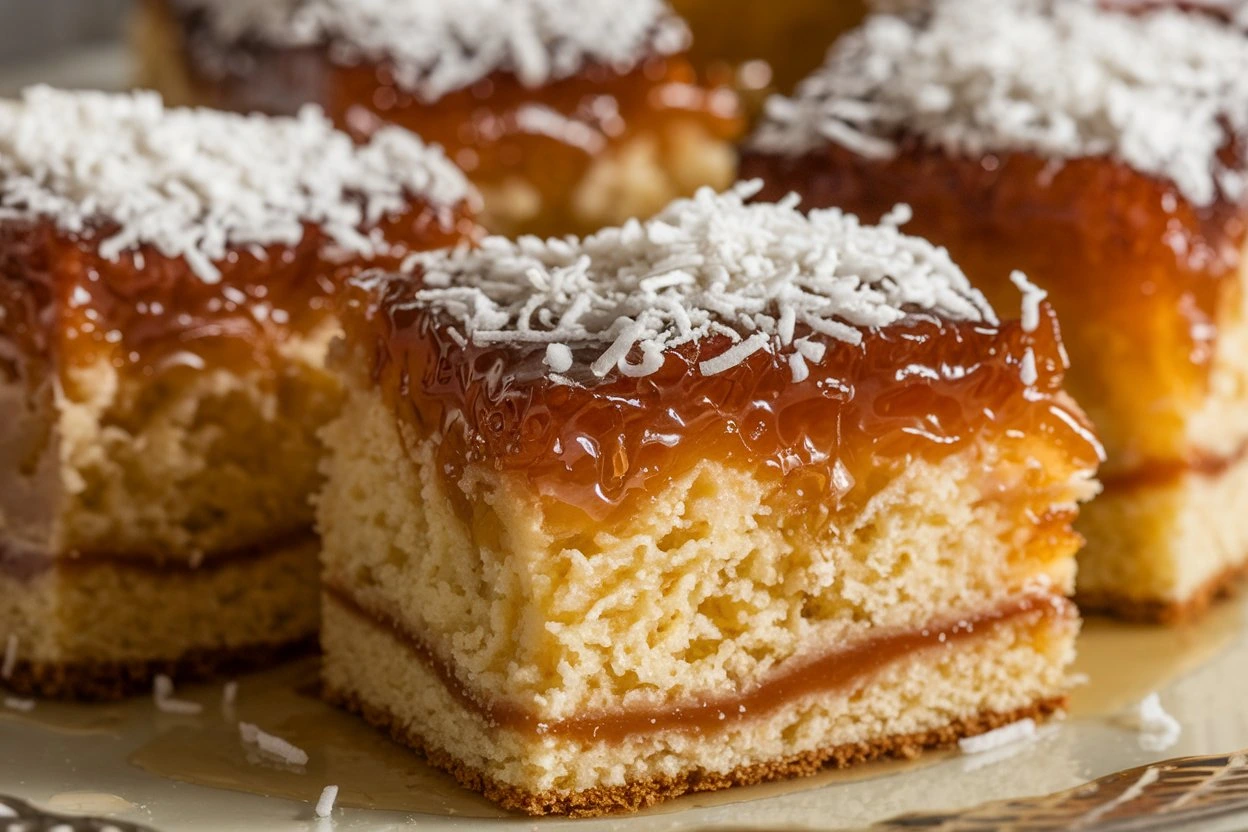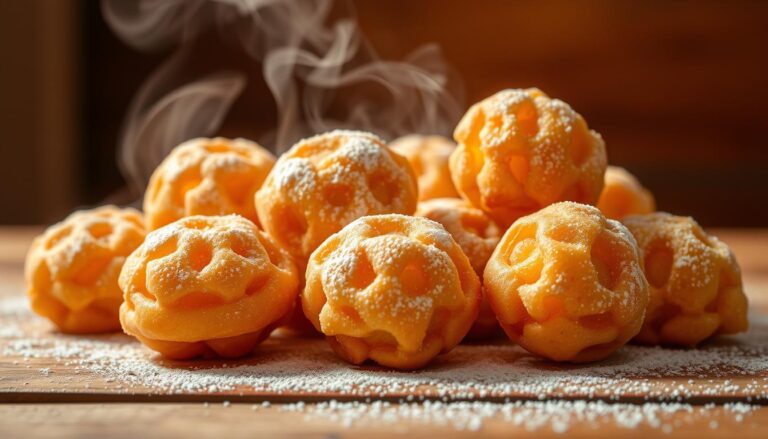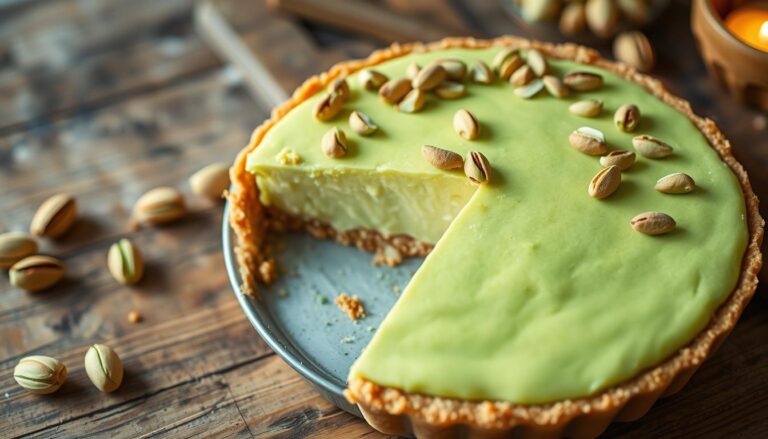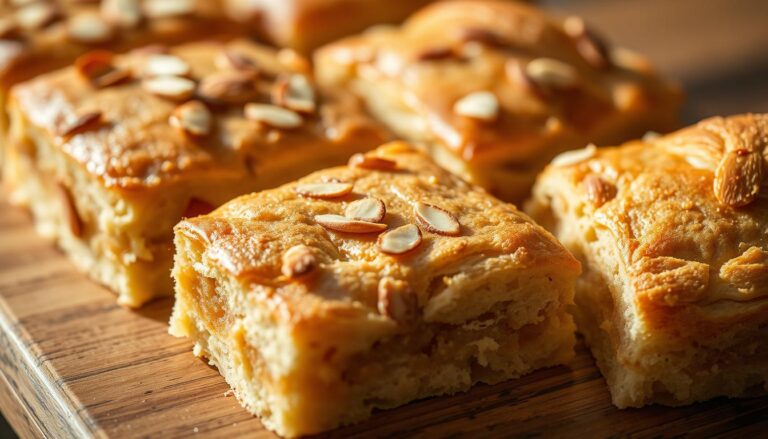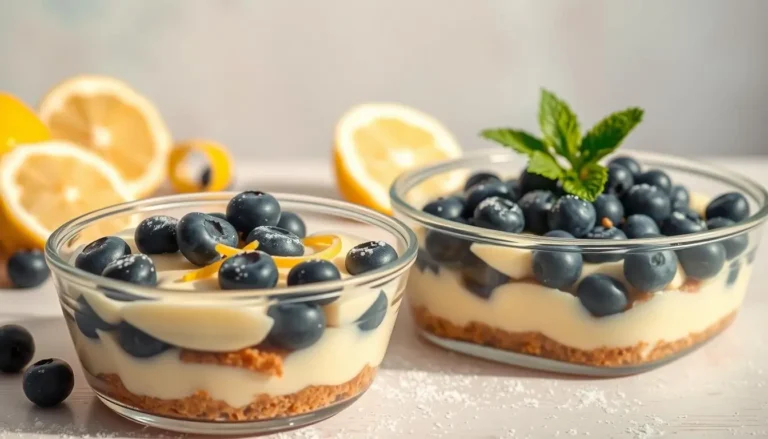Sticky Coconut Cake
Table of Contents
Imagine enjoying a yummy sweet treat that’s both tasty and simple to make. You’re about to enter the world of Indonesian Sticky Coconut Cake. This gluten-free delight is a must-try for coconut fans.
This Sticky Coconut Cake is a coconut-filled treat that’s great for satisfying your sweet cravings. Its sticky texture and coconut flavor make it a favorite among dessert lovers.
Key Takeaways
- Easy to make and delicious
- Gluten-free Indonesian dessert
- Perfect for coconut lovers
- Sticky texture and coconut flavor
- A must-try dessert snack
What Makes Coconut Cake So Irresistible?
Coconut cake is loved for its mix of flavors, textures, and cultural ties. It’s the perfect blend that makes it hard to resist. You might be drawn to it for many reasons.
The Unique Flavor Profile
Coconut cake has a distinct taste that’s both rich and subtle. It offers a deep, tropical flavor from coconut. The sweetness hits you first, then the lingering coconut notes follow, making it a joy to eat.
Several factors contribute to its unique taste:
- The quality of coconut used, whether it’s shredded coconut or coconut milk
- The balance between coconut and other ingredients like sugar, eggs, and flour
- The addition of flavor enhancers such as vanilla or lime zest
A Textural Delight
The texture of coconut cake is a big part of its charm. It can be moist and fluffy or denser, depending on the recipe. The soft cake and crunchy coconut flakes make it a treat for the senses.
To get the best texture, try these tips:
- Make sure your ingredients are at room temperature before mixing
- Avoid overmixing the batter to prevent a dense cake
- Choose the right coconut and mix it well into the batter
Cultural Significance
Coconut cake is a treasure in many cultures, often found in tropical areas where coconut is common. In Asian desserts, coconut is a key ingredient, showing its versatility.
For many, coconut cake brings back memories of special times or cultural events. Its cultural importance adds to its emotional value, making it more than just a dessert.
Ingredients You’ll Need for Your Cake
The key to a great coconut cake is in its ingredients. We’ll go over them below. To make your cake moist and tasty, knowing each ingredient’s role is important.
Essential Ingredients
First, gather the essential ingredients for your coconut cake. These are:
- Eggs, which give structure and richness
- Granulated sugar, adding sweetness and softness
- Full-fat canned coconut milk, for moisture and flavor
- Shredded sweetened coconut, boosting coconut taste and texture
- Glutinous rice flour, for the right texture
- Vanilla extract, for a hint of flavor
Optional Add-Ins for Flavor
For a richer taste, add optional add-ins. Think about:
- Nuts like macadamia or almonds for crunch
- Dried fruits such as cranberries or cherries for a fruity twist
- Coconut flakes or shredded coconut for more coconut flavor
- Spices like cinnamon or nutmeg to complement the coconut
Tools for the Perfect Bake
Right tools are as crucial as the ingredients. Make sure you have:
- A non-stick cake pan to prevent sticking
- A mixing bowl and measuring cups for accurate measurement
- An electric mixer for easy batter preparation
- A cooling rack for proper cooling
With these ingredients, add-ins, and tools, you’re ready to bake a delicious coconut cake. It’s sure to wow everyone.
Step-by-Step Guide to Baking the Cake
To make the perfect sticky coconut cake, just follow this easy guide. Baking a desserts cake needs focus, but these steps will help you make a tasty treat.
Preparing the Batter
First, heat your oven to 350° F. While it warms up, mix egg whites and sugar until smooth. This step adds air and makes your cakes and pies light.
Then, add coconut milk, shredded coconut, rice flour, and a bit of vanilla. These ingredients mix to create a moist cake with a coconut taste.
Baking Tips and Tricks
Put the batter in your cake pan and bake for 45 minutes. A toothpick should come out clean when it’s done. To bake evenly, turn the pan halfway through.
This trick helps your desserts cake bake perfectly.
Cooling and Storing Properly
After baking, let the cake cool in the pan for a few minutes. Then, move it to a wire rack to cool fully. Cooling right is key for keeping the cake’s texture.
When it’s cool, store it in an airtight container. This keeps your cakes and pies fresh longer.
By following these steps, you can make a delicious sticky coconut cake. It looks great too. This guide is easy for anyone to follow, whether you’re new to baking or experienced.
Frosting Options to Elevate Your Cake
The right frosting can really make your coconut cake stand out. It adds flavor and makes the cake look amazing. This makes it a hit at any event.
Choosing the right frosting is key. It changes how your cake tastes and looks. Here are some great options:
Classic Coconut Cream Frosting
A classic coconut cream frosting is a great choice. You need icing sugar, coconut cream, and a bit of vanilla. Whip the coconut cream until it’s fluffy, then sweeten it with icing sugar.
Coconut cream frosting has many benefits:
- It’s light and fluffy, contrasting with the dense cake.
- The coconut flavor is enhanced, making the taste experience better.
- It’s easy to make, needing just a few ingredients.
Cream Cheese Frosting Variations
For a tangy contrast, try a cream cheese frosting. Mix butter, icing sugar, cold cream cheese, and vanilla. You can also add coconut essence for a tie-in with the cake.
Here are some variations:
- Add a pinch of salt to balance the sweetness.
- Include shredded coconut for texture.
- Try different flavor extracts like lemon or orange for a twist.
Fondant and Other Fancy Options
For a fancy look, use fondant or other fancy frostings. Fondant is great for designs and is perfect for special events.
Other fancy options include:
- Buttercream with coconut extract.
- Whipped cream for a light texture.
- Ganache for a rich flavor.
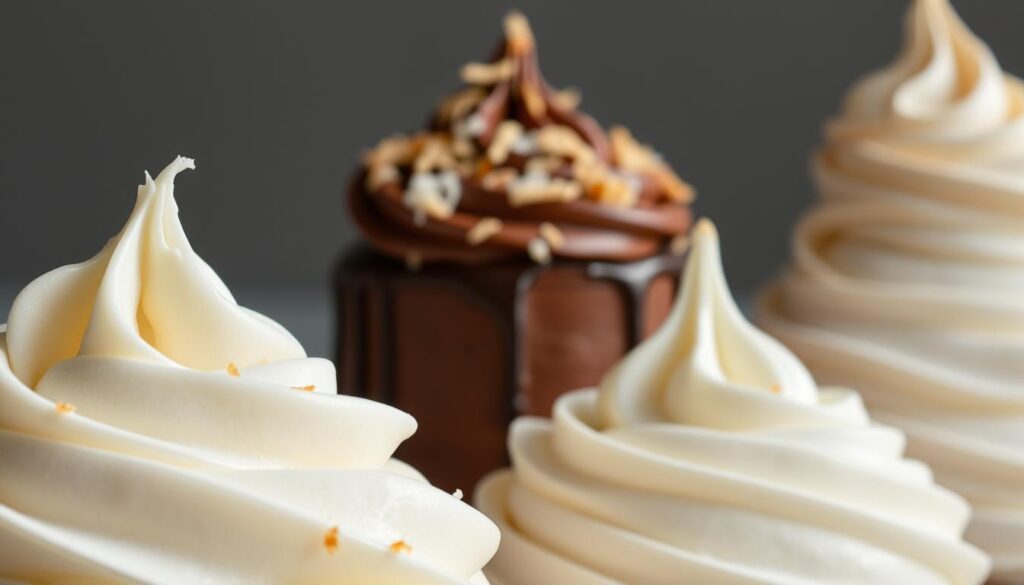
Choosing the right frosting can turn your coconut cake into a showstopper. Whether you go for coconut cream, cream cheese, or fondant, there’s a frosting for every taste and occasion.
Decorating Your Coconut Cake
Decorating your coconut cake can turn it into a stunning masterpiece. The right decorations make your cake look great and taste even better. You can pick from many decorating techniques to match your event and style.
Simple Garnishes for a Rustic Look
For a cozy, rustic look, try simple garnishes. Shredded coconut is perfect as it matches the cake’s taste and feel. You can also add toasted coconut flakes or chopped nuts for extra crunch.
- Sprinkle shredded coconut on top of the frosting for a textured look.
- Use caramelized edges to add a golden brown appeal.
- Garnish with fresh fruits like raspberries or strawberries for a pop of color.
Elegant Presentation Ideas
For a special occasion, go for elegant presentation ideas. Use an offset spatula to spread frosting for a smooth, professional look.
| Decoration Idea | Occasion | Tips |
|---|---|---|
| Fondant designs | Weddings, Anniversaries | Use colored fondant to match your theme. |
| Coconut cream frosting | Birthdays, Gatherings | Top with toasted coconut flakes. |
| Fresh flowers | Special occasions | Ensure flowers are edible and safe. |
Seasonal Decorations
Make your coconut cake decorations fit the season for a festive touch. For example, use holly sprigs and red berries for Christmas or pastel colors and flowers for Easter.
- For summer, consider using bright colors and tropical flowers.
- In autumn, incorporate elements like leaves and pumpkins.
- For winter, snowflakes and white chocolate shavings can create a beautiful effect.
Coconut Cake for Special Occasions
Coconut cake is perfect for birthdays, weddings, or holidays. Its unique taste and flexibility make it great for any celebration.
Coconut desserts, like coconut cake, are loved worldwide for their rich, tropical flavor. You can easily make this cake fit your event’s theme. It’s a go-to dessert for any celebration.
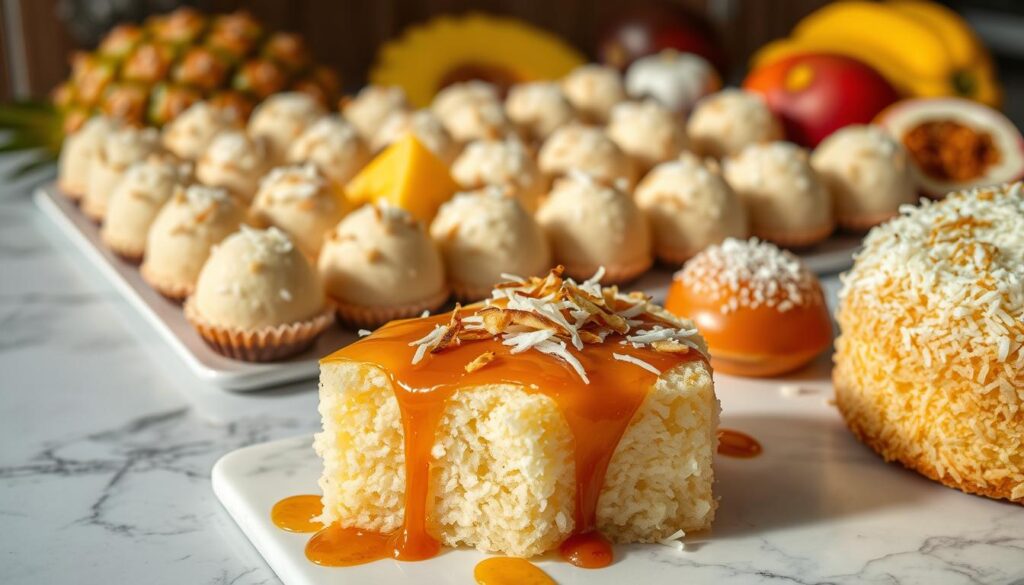
Birthday Celebrations
For birthdays, decorate your coconut cake with themed decorations or fillings. Adding a layer of coconut cream or fresh fruits makes it extra special.
Weddings and Anniversaries
Coconut cake is elegant for weddings and anniversaries. Choose a multi-tiered cake or a simple design. It’s perfect for parties and holidays because you can make it ahead and refrigerate it.
Holidays and Festivities
Coconut cake is a refreshing twist on traditional desserts for holidays. Add seasonal flavors or decorations to make it festive. A hint of cinnamon or nutmeg can give it a warm, holiday feel.
Adapting your coconut cake to the occasion makes it a memorable dessert for your guests.
Pairing Beverages with Coconut Cake
The rich flavor of coconut cake can be elevated by the perfect beverage pairing. Whether you’re enjoying it as an afternoon treat or as a dessert after dinner, the right drink can complement its unique flavor profile and texture.
You might find that a cold glass of milk or a hot cup of coffee pairs perfectly with your coconut cake, but there are many other options to explore. For instance, the cake is delicious as an afternoon treat with a Philz Mint Mojito Iced Coffee, offering a refreshing twist on traditional coffee.
Best Coffee Choices
Coffee is a classic pairing for many desserts, and coconut cake is no exception. The bitterness of the coffee complements the sweetness of the cake, creating a balanced flavor experience.
- Cold Brew Coffee: Smooth and less acidic, cold brew coffee is a great match for coconut cake, making it perfect for warmer months.
- Iced Coffee with Vanilla Syrup: Adding a hint of vanilla to your iced coffee can enhance the coconut flavors in the cake.
- Café au Lait: For those who prefer a milder coffee flavor, café au lait offers a comforting and creamy pairing.
Refreshing Tea Options
Tea is another excellent choice to pair with coconut cake, offering a range of flavors that can complement its richness.
- Jasmine Green Tea: The floral notes of jasmine green tea can beautifully contrast with the coconut flavors.
- Chai Tea: Spiced chai tea, with its warming spices, can add a delightful dimension to the coconut cake experience.
- Hibiscus Tea: For a caffeine-free option, hibiscus tea provides a fruity and refreshing contrast to the richness of the cake.
Wine Pairings That Work
For a more adult-oriented dessert experience, wine can be a sophisticated pairing option for coconut cake.
- Moscato: The sweetness and effervescence of Moscato make it a delightful match for coconut cake.
- Riesling: A dry Riesling can cut through the richness of the cake, offering a balanced taste experience.
- Pinot Grigio: This crisp and refreshing white wine can cleanse the palate between bites of coconut cake.
| Beverage | Type | Flavor Profile |
|---|---|---|
| Cold Brew Coffee | Coffee | Smooth, less acidic |
| Jasmine Green Tea | Tea | Floral, refreshing |
| Moscato | Wine | Sweet, effervescent |
Creative Uses for Leftover Coconut Cake
Don’t let leftover coconut cake go to waste. Instead, turn it into new and exciting desserts. Cut the cake into squares or triangles. Serve it cold from the fridge or at room temperature. This makes it a versatile base for various creative desserts.
Coconut Cake Trifles
One impressive way to use leftover coconut cake is in a trifle. Layer the cake with whipped cream, fresh fruits, and toasted coconut flakes in a large bowl or individual glasses. This dessert looks great and has different textures and flavors. It’s a hit at any gathering.
Cake Pops and Bites
Turning leftover cake into cake pops or bite-sized treats is fun. Crumb the cake and mix it with a bit of frosting to bind it. Then, shape the mixture into balls or use cookie cutters for fun shapes. Dip these into melted chocolate and decorate with sprinkles or toasted coconut flakes. These treats are perfect for parties or as a sweet snack.
Ice Cream Sandwiches
Using leftover coconut cake for ice cream sandwiches is a tasty idea. Slice the cake into thin layers, place a scoop of your favorite ice cream between two slices, and freeze until firm. The coconut cake goes well with coconut or vanilla ice cream. This dessert is a crowd-pleaser during warm weather or when you crave something cold and sweet.
By getting creative with leftover coconut cake, you can enjoy new desserts without baking from scratch. Whether you make trifles, cake pops, or ice cream sandwiches, you’ll impress your family and friends with your culinary creativity.
Common Mistakes to Avoid When Baking
A successful coconut cake avoids simple but key baking mistakes. Even seasoned bakers can make errors that harm the cake’s quality. Knowing these common mistakes helps ensure your coconut cake is both tasty and beautiful.
Overmixing the Batter
Overmixing can make your cake dense and tough. It happens when you mix the batter too much, causing the flour’s gluten to develop. To prevent this, mix wet and dry ingredients separately and gently combine them. Stop mixing as soon as they’re just combined; it’s easy to overmix quickly.
Not Measuring Ingredients Correctly
Accurate ingredient measurement is key in baking. Unlike cooking, where you can adjust flavors, baking needs precision. Too much or too little of any ingredient can ruin the recipe’s balance. Use a digital scale and measuring cups for accurate amounts. Always double-check your measurements before starting.
- Use a digital scale for precise measurements.
- Level off dry ingredients with a straight edge.
- Measure liquids at eye level to ensure accuracy.
Ignoring Baking Temperatures
Baking temperature greatly impacts your cake’s outcome. Wrong oven temperature can lead to undercooked or overcooked cakes. Always preheat your oven and consider an oven thermometer for accurate temperature checks. This simple step can greatly improve your baked goods.
- Preheat your oven to the specified temperature.
- Use an oven thermometer to check the temperature.
- Adjust your oven settings if necessary.
By avoiding these common mistakes, you’ll bake a perfect coconut cake every time. Happy baking!
Healthier Substitutes for Coconut Cake
Want to make coconut cake healthier? There are many substitutions that keep the flavor great. These changes are perfect for those with dietary needs or just wanting a cleaner dessert.
Gluten-Free Alternatives
To make coconut cake gluten-free, try using almond flour or coconut flour. But remember, you might need to add more liquid because they soak up a lot. Glutinous rice flour is another good choice. It’s gluten-free and adds a special texture, common in Asian desserts.
Reducing Sugar Without Compromising Flavor
Want less sugar in your coconut cake? Use honey or maple syrup instead. They’re natural sweeteners that taste great and cut down on refined sugar. Also, unsweetened shredded coconut boosts the coconut taste, so you can use less sugar.
Using Natural Oils
Switch butter or margarine for coconut oil or avocado oil. They make the cake moist and flavorful. Coconut oil, in particular, pairs well with coconut, making the taste even better. These oils are healthier, making your coconut cake more nutritious.
With these healthier options, you can enjoy coconut cake that’s tasty and fits many diets and tastes.
Frequently Asked Questions About Coconut Cake
Exploring yummy sweets, like cakes and pies, might raise some questions. Here, we answer common ones to help you bake better.
Maintaining Moisture
To keep your coconut cake moist, don’t overbake it. Store it in an airtight container at room temperature or in the fridge. This keeps it fresh.
Freezing Coconut Cake
Yes, you can freeze coconut cake. Wrap it in plastic wrap or foil and freeze for up to 3 months. Thaw it at room temperature or in the fridge overnight before serving.
Substituting Coconut Products
Looking for coconut substitutes? Try almond extract or other nut flavors. You can also use different milks or creams to change the taste and texture of your cakes and pies.

